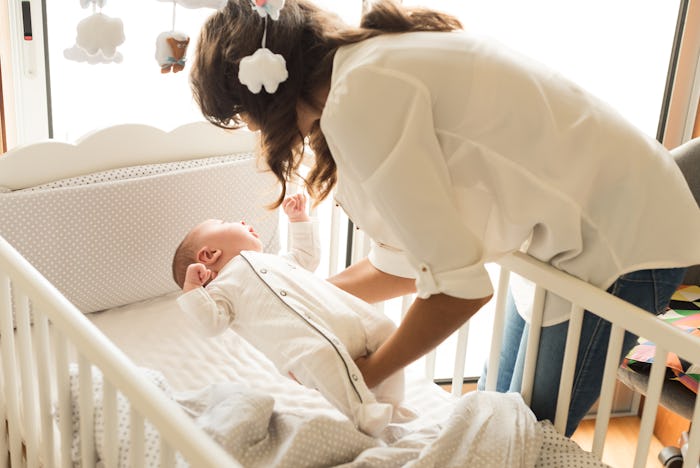Life

How To Transition To Crying It Out When You're Finished Co-Sleeping
When it comes to your baby's sleep arrangements, there's no end to your options and choices. Co-sleeping is one of them, and can end up being a wonderful way to stay close to your baby, encourage bonding, and increase your breastfeeding success (if you choose to and/or are able to nurse). At some point, though, you'll probably want separate rooms for you and your child. In other words, you'll have to figure out how to transition to crying it out after you're finished with co-sleeping, if, of course, that's the sleep training method you decide to use.
Contrary to popular belief, co-sleeping actually pertains to a few sleeping situations. According to KellyMom, co-sleeping can mean parents sleeping in the same bed with their child (also referred to as bed-sharing), using a sidecar arrangement in which parents securely attach a crib to one side of the parents' bed, or a baby sleeping in a bassinet or crib but in the parents' room.
The Baby Sleep Site defines the cry it out (CIO) method, on the other hand, as a sleep training method used to break poor sleep associations. In other words, and according to the same site, parents set "limits on what you will and won't allow your baby to do" at nap time, all night, and during any other sleep-related situation. Parents check on their babies at specific intervals in order to help them learn how to self-soothe and, eventually, put themselves to sleep. The Mayo Clinic suggest if you have tried other ways to calm your baby, and those other methods have proven unsuccessful, it's OK to let them cry it out, adding, "crying won't hurt your baby — and sometimes the only way to stop a crying spell is to let it run its course."
The cry it out sleep training method isn't without its critics, though. In fact, more than a few naysayers claim the method can damage children's development, regardless of a recent study at Flinders University in Australia, published in Pediatrics, that found babies who were subjected to cry it out "were no more stressed than babies whose parents used bedtime fading, or the technique of moving bedtime later in hope that the child will fall asleep more quickly."
If you decide to use CIO methods after co-sleeping, The Baby Sleep Site has some tips for the transition. The site suggests parents first sleep together in the baby's new room, then stay with the baby until they fall asleep, then move on to leaving the room before the baby falls asleep entirely. The site also makes a point of saying the following, which is a great reminder for all parents looking to switch up their family's sleeping arrangements: "what we want to leave you with is this: there is no 'right' or 'wrong' sleeping arrangement for you and your baby, provided your sleeping arrangements are safe."
Transitioning from co-sleeping to crying it out will be a gradual progression, to be sure, and the entire family will go through an adjustment period. If the recommended cry it out methods are followed, however, some sleep-filled nights should be on the horizon.
While The Baby Sleep Site highlights what cry it out isn't, including a replacement for feeding when baby can not comfortably sleep all night without food, meant to be used when a baby is hungry, wet, very sick, or in pain, closing a baby in a room and ignoring them forever and ever, or a replacement for parenting when a baby needs it, researchers have found that babies who cry it out fall asleep more quickly than those who do not.
The American Sleep Association stresses how important good quality and restorative sleep is to the whole family, and even encourages parents to consider the potential damage of being sleep deprived when discussing and/or choosing a sleep routine. Human beings cannot function properly if we are not well rested. So, if your baby is keeping you both up and you've had it with co-sleeping, crying it out just might be right for you.
In the end and always, you're the only one who knows what's best for yourself, your baby, and your entire family. So, good luck and happy sleeping (hopefully)!